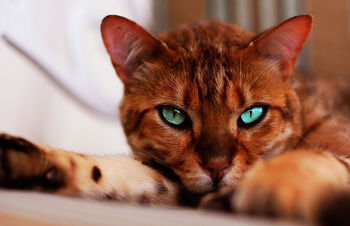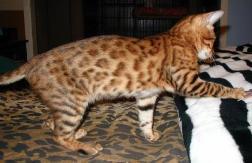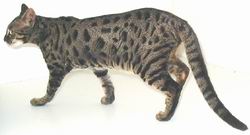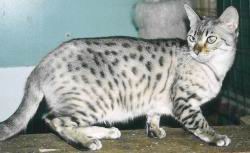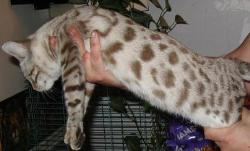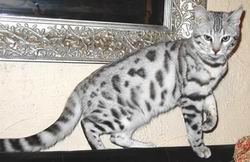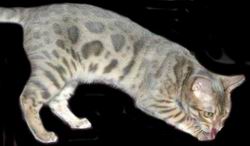Miss Sophie (talk | contribs) No edit summary |
Miss Sophie (talk | contribs) No edit summary |
||
| Line 95: | Line 95: | ||
colours the ''Brown Bengal'' and the ''Snow Bengal'' and two patterns in both the colours - ''Spotted/Rosetted'' and |
colours the ''Brown Bengal'' and the ''Snow Bengal'' and two patterns in both the colours - ''Spotted/Rosetted'' and |
||
''Marbled''. |
''Marbled''. |
||
| + | {{col-begin}} |
||
| + | {{col-2}} |
||
==== Leopard Spotted ==== |
==== Leopard Spotted ==== |
||
| ⚫ | |||
[[File:Leopard_Bengal.jpg|left]] |
[[File:Leopard_Bengal.jpg|left]] |
||
| + | Registered as brown spotted tabbies. |
||
| ⚫ | |||
| + | {{col-2}} |
||
| ⚫ | |||
| + | [[File:Sorrel_Bengal.jpg|left]] |
||
| + | Also registered as brown spotted tabbies. |
||
| ⚫ | |||
| + | {{col-end}} |
||
| ⚫ | |||
| + | {{col-begin}} |
||
| + | {{col-2}} |
||
| ⚫ | |||
| + | [[File:Charcoal_Bengal.jpg|left]] |
||
| + | Also registered as brown spotted tabbies. |
||
| ⚫ | |||
| + | {{col-2}} |
||
| ⚫ | |||
| + | [[File:Tri-Color_Marbles.jpg|left]] |
||
| + | Large swirled (marbled) patches of color. |
||
| + | Pattern must flow in a long horizontal movement. |
||
| ⚫ | |||
| − | |||
| + | {{col-end}} |
||
| − | |||
---- |
---- |
||
| + | {{col-begin}} |
||
| + | {{col-2}} |
||
| ⚫ | |||
| + | [[File:Sorrel_Marbles.jpg|left]] |
||
| + | Registered as brown marble tabbies. |
||
| ⚫ | |||
| + | {{col-2}} |
||
| ⚫ | |||
| + | [[File:Seal_Lynx_Point_Snows.jpg|left]] |
||
| + | Born pure white. |
||
| + | Patterns emerge as the cat ages. |
||
| ⚫ | |||
| − | |||
| + | {{col-end}} |
||
| − | |||
| ⚫ | |||
| ⚫ | |||
| − | |||
| − | |||
| − | |||
| − | |||
| − | |||
| − | |||
| − | |||
| − | |||
| − | |||
| − | |||
---- |
---- |
||
| + | {{col-begin}} |
||
| + | {{col-2}} |
||
| ⚫ | |||
| + | [[File:Seal_Mink_Snows.jpg|left]] |
||
| ⚫ | |||
| + | Mink snows have aqua colored eyes. |
||
| + | {{col-2}} |
||
| ⚫ | |||
| + | [[File:Seal_Sepia_Snows.jpg|left]] |
||
| + | Born with deep chocolate brown markings. |
||
| ⚫ | |||
| + | Sepias have yellow, to a yellow/green eye color. |
||
| − | |||
| + | {{col-end}} |
||
| ⚫ | |||
| ⚫ | |||
| − | |||
| − | |||
| − | |||
| − | |||
| − | |||
| − | |||
| − | |||
| − | |||
| − | |||
| − | |||
| ⚫ | |||
| ⚫ | |||
| ⚫ | |||
---- |
---- |
||
| + | {{col-begin}} |
||
| ⚫ | |||
| + | {{col-2}} |
||
| ⚫ | |||
| ⚫ | |||
| − | ---- |
||
| + | [[File:Charcoal_Snows.jpg|left]] |
||
| ⚫ | |||
| + | Can be found in seal lynx, seal mink, or seal sepia. |
||
| ⚫ | |||
| ⚫ | |||
| − | ---- |
||
| + | Eye color can be non-traditional for the snow phase in question. |
||
| ⚫ | |||
| + | {{col-end}} |
||
| ⚫ | |||
| − | ---- |
||
| ⚫ | |||
| ⚫ | |||
| − | ---- |
||
| − | |||
| ⚫ | |||
| ⚫ | |||
| − | ---- |
||
=== Experimental Colors === |
=== Experimental Colors === |
||
| Line 176: | Line 185: | ||
---- |
---- |
||
| + | {{col-begin}} |
||
| + | {{col-2}} |
||
==== Silver Bengals ==== |
==== Silver Bengals ==== |
||
| + | [[File:Silver_Bengal.jpg|left]] |
||
| ⚫ | |||
| + | Being shown in NBC with several registries, silver Bengals are gaining popularity. |
||
| − | ---- |
||
| + | |||
| ⚫ | |||
| + | {{col-2}} |
||
==== Blue Bengals ==== |
==== Blue Bengals ==== |
||
| + | [[File:Blue_Bengal.jpg|left]] |
||
| − | Being shown in NBC with several registries, blue Bengals are known as "unwanted" recessives. |
+ | Being shown in NBC with several registries, blue Bengals are known as "unwanted" recessives. |
| + | |||
| + | Blue/grey markings on light grey, they don't replicate the Leopard Cat color. |
||
| + | {{col-end}} |
||
---- |
---- |
||
| + | {{col-begin}} |
||
| + | {{col-2}} |
||
==== Black Bengals ==== |
==== Black Bengals ==== |
||
| + | [[File:Black_Bengal.jpg|left]] |
||
| − | Being shown in NBC with several registries, black Bengals are often sold as ''Pantherettes'' |
+ | Being shown in NBC with several registries, black Bengals are often sold as ''Pantherettes''. |
| + | |||
| + | These cats are black marked on a black background. |
||
| + | {{col-end}} |
||
== New Developments == |
== New Developments == |
||
Revision as of 18:46, 27 January 2010
The Bengal is a relatively new hybrid breed of cat, formed by the cross of a domestic feline and an Asian Leopard Cat ("ALC").
Bengal cats have "wild-looking" markings, such as large spots, rosettes, and a light/white belly, and a body structure reminiscent of the Leopard Cat (Prionailurus bengalensis bengalensis). The Bengal cat has a desirable "wild" appearance with a gentle domestic cat temperament, provided it is separated by at least three generations from the original crossing between a domestic feline and an Asian Leopard Cat.
The name Bengal cat was derived from the taxonomic name of the Asian Leopard Cat (P. b. bengalensis), and not from the unrelated Bengal tiger.
History
The earliest mention of an ALC/domestic cross was in 1889, Harrison Weir wrote in Our Cats and All About Them
There is a rich-coloured brown tabby hybrid to be seen at the Zoological Society Gardens in Regent's Park, between the wild cat of Bengal and a tabby she-cat. It is handsome, but very wild. These hybrids, I am told, will breed again with tame variety, or with others. However in 1927, Mr Boden-Kloss wrote to the magazine "Cat Gossip" regarding hybrids between wild and domestic cats in Malaya: I have never heard of hybrids between bengalensis (the Leopard Cat) and domestic cats. One of the wild tribes of the Malay Peninsula has domesticated cats, and I have seen the woman suckling bengalensis kittens, but I do not know whether the latter survive and breed with the others!
The earliest mention of a confirmed ALC/domestic cross was in 1934 in a Belgian scientific journal, and in 1941 a Japanese cat publication printed an article about one that was kept as a pet (As a point of interest, Jean Mill [née Sugden], the person who was later a great influence of the development of the modern Bengal breed, submitted a term paper for her genetics class at UC Davis on the subject of cross breeding cats in 1946). A Bengal cat displaying spotting and rosetting pattern typical of the breed. Rosetted spots occur only on the back and sides, with stripes elsewhere.
The 1960s was a period when many well known breeders, including Jean Sugden, produced ALC/domestic crosses, but records indicate that none of them took it past the F2 stage. Several zoos in Europe also produced a number of F1 ALC crosses. During this period there was an epidemic of feline leukemia virus and it became known that many wild cats seemed to have a natural immunity to the disease. As a result of this, Loyola University would start a research program in the 1970s to investigate if this natural immunity could be bred in or replicated.
Throughout the 1960s and 1970s there was a great deal of activity with hybrids, but there was no significant effort to create an actual breed from them. A number of Cat clubs formed that oriented on hybrids and a few oriented specifically on something William Engler, a member of the Long Island Ocelot Club and a breeder, called Bengal.
Club newsletters detailing the production of Bengals and Safaris started being published and members of these clubs bred some second and third generation Bengals. These were registered with the American Cat Fanciers Association (A.C.F.A.) in 1977 as experimental and were shown at several A.C.F.A. cat shows throughout the 1970s.
Around this time, Jean Mill (née Sugden) resurfaced again, and the following quote explains her increased interest in renewing her breeding efforts. ..I deliberately crossed leopard cats with domestic cats for several important reasons. At that time, wild cats were being exploited for the fur market. Nursing female leopard cats defending their nests were shot for their pelts, and the cubs were shipped off to pet stores worldwide. Unsuspecting cat lovers bought them, unaware of the danger, their unpleasant elimination habits and the unsuitability of keeping wild cats as pets. Most of the wild kittens from this era ended up in zoos or escaped onto city streets. I hoped that by putting a leopard coat on a domestic cat, the pet trade could be safely satisfied. If fashionable women could be dissuaded from wearing furs that look like friends' pets, the diminished demand would result in less poaching of wild species.
She contacted Dr. Willard Centerwall in Riverside who had produced a number of F1s using domestic tabbies at Loma Linda University for his Centerwall project into Feline Leukemia. Once the F1s had donated blood samples for his research, he needed homes for them. He gave Jean 4 hybrids. She later received another 5 hybrids from another source, but originally from the same Centerwall project.
Contrary to popular belief, Jean did not use local domestics to create her first Bengals. She felt the ALC was a genetically superior animal and wished to avoid weakening this element. Around 1982, the Mills made a trip to India where a zoo curator showed them a feral Indian Mau. This was how the famous rosetted domestic called "Millwood Tory of Delhi" came to be found in virtually all Bengal pedigrees. A male Bengal cat. Note "mascara" (horizontal striping alongside the eyes) and foreleg striping, both typical of the breed.
Credit also needs to be given at this point to Greg and Elizabeth Kent, who developed their own line of Bengals using ALCs and Egyptian Maus. This was a very successful line and many modern Bengals will find it in their pedigree.
Jean Mill and the Kents worked hard to popularize the breed, and when the public saw the result of their work, word spread quickly. As the number of breeders and owners grew, it led to the formation of T.I.C.A.'s Bengal Breed Section. T.I.C.A. adopted the first written breed standard in 1986 and the first Bengal Bulletin was published in Nov/Dec 1988.
Shortly after The International Bengal Cat Society (T.I.B.C.S.), the Bengal Breeders Alliance (B.B.A.) and the Authentic Bengal Cat League (A.B.C.L.) were formed. These organizations exist to promote good breeding practices, discourage unscrupulous breeders, and attempt to educate people about the Bengal breed.
Although they have become a popular breeds, with over 60,000 cats registered with T.I.C.A., not all cat registries accept them - in particular the Cat Fanciers' Association, one of the largest cat registries in the world, does not accept any hybrids.
Breed Description
Coat
The spotted variety of the Bengal can take on many differences in patterns. A spotted Bengal can have a solid spot of one color, or we can have a rosetted Bengal. A rosetted Bengal is still spotted, but the spots have two colors to them. Usually there is a dark spot of either brown or black, and then a kind of rust or orange shading inside or around the spot, creating a Rosette like you would see on a wild cat like a jaguar. Often times you will hear breeders refer to a clear or a ticked coat. A clear coat is when there is a dramatic difference between the spotting pattern and the background. The spots are very dark in color and the background color does not compete with the spots. Some cats have what we call Glitter, and this is when the hair tip is hollow, and reflects light, making the cat look as if it was dusted with golden specks throughout the hair. A ticked coat is when the hair tips are whitish, and this white tipping on the pattern makes it seem to fade into the background color. Bengal kittens go through a stage we call the Fuzzies. This is a type of camouflage, as you would see on wild cats babies. The fuzzy stage can begin as early as four weeks, and last until the kitten is over twelve weeks. When in the fuzzies, the kittens coat can become very thick and bushy, and get ticked and dull in color. But...once they are out of this stage, a baby Bengal gets brighter in color, and darker in the pattern. It can take up to a full year for all the rich colors to come into a Bengal coat. Marble baby Bengals are born mostly two colors. The pattern areas are a very solid dark area. But, as the baby grows and matures, the pattern Falls out. What this means is that the outline of the dark areas remain, but the inside seems to lighten up and change to a gorgeous rich third color separate from the outlining and the background. Bengals can sometimes be born with a long haired coat. Because of the use of domestic "street" cats in the early breeding of Bengal Cats, longhaired recessives can pop up if you match a male and female who both carry for longhair. The coat is long around the neck, the tail and the belly, and remains shorter on the back and shoulders. Very similar in coat to a Maine Coon.
Overview
Bengals form strong, loving and completely devoted bonds with their owners and this combined with their highly sociable nature will find them having to be involved in everything that their owners are doing. This sociability extends to other animals and Bengals get on well and form loving bonds with most animals.
Character
The Bengal resulted from a breeders efforts in 1963 to help save endangered wild cats (then available for sale in pets shops) by creating a domestic version cat lovers could have at home. Jean Mill of Millwood cattery, CA crossed a wild female Asian Leopard Cat (Prionailurus bengalensis) with a shorthaired male domestic cat & this marked the beginning of the breed known today as the Bengal.
Through selective breeding, Abundadots Bengals possess incredible temperaments. Affectionate and inquisitive, these cats want to be with you at all times! At Abundadots Bengals, we spend a lot of time with our kittens as they grow up, and all live in the house with us. We feel that early socialization is important for kittens and creates a strong bonding instinct to people, and most Bengals that are treated with love and kindness crave human contact.
A Bengal's call is unique, and often they growl when upset rather than hissing. Bengals are not an overly vocal cat, crying for unknown reasons, but they will chatter back when you talk to them. Kittens often growl at their toys, and make funny yum, yum, yum sounds when they eat! Bengals will often jump in the tub or shower with you and retain a love of water, just as their wild ancestors do. They can learn to play fetch, walk on a harness and leash, retrieve small toys, and will often carry objects in their front paws.
Temperament
A Bengal cat is athletic, lively, alert to its surroundings, nosey, intelligent, friendly, chatty and confident. As a kitten they will walk into their new home and take over your life such is their assurance in themselves. They have strong personalities and are highly adjustable to new experiences and surroundings. Allot of Bengals are happy to and infarct insist on travelling away on holiday with their owners.
Training
Being highly intelligent the Bengal is easily trainable, to a harness or to chase and fetch.
Activity
This playfulness, highly energetic and devoted nature makes them wonderful interactive companions for children. A favourite toy will be retrieved for hours on end and feather wands chased unfalteringly until the feathers fall out or the human gets bored of the game, Bengals are also known to collect and hoard their treasures. This playful nature also extends into the Bengals fondness for water and water play.......which isn't restricted to indoors.
Ownership
The Bengal is a energetic busy cat, always on the go and with a real love of life. They are definitely not a couch potato cat but, if you want a cat that is totally devoted, interactive, fun and a valued contributing member of your family the beautiful Bengal may be for you.
Appearance
The Bengal cat is a medium to large sized cat which exhibits good strong boning and a very muscular build, which is especially obvious in the males being the larger of the two. Often the females smaller size can be misleading until she is picked up and being able to feel the weight and strength of the cat. Its wide nose with prominent whisker pads and large oval, almost round eyes in a slightly small head in proportion to the body enhance the wild appearance and expressive nocturnal look. Its very slight, nearly straight concave profile, and relatively small ears all add to the Bengals unique and distinctive appearance. Bengal cats have also the "wild-looking" markings, such as large spots, rosettes, and a light/white belly, and a body structure reminiscent of the Leopard Cat. The Bengal's rosetted spots occur only on the back and sides, with stripes elsewhere. The breed typically also features "mascara" (horizontal striping alongside the eyes), and foreleg striping.
The International Cat Association (TICA) recognizes several Bengal colors (brown, seal lynx point, mink, sepia, silver) and patterns (spotted and marbled) for competition. In the New Traits class, other colors may be shown, as well as longhairs
Colors and Patterns
The Bengals beautiful coat makes it stand out in the crowd. In New Zealand the Bengal cat is currently recognised in two colours the Brown Bengal and the Snow Bengal and two patterns in both the colours - Spotted/Rosetted and Marbled.
Leopard SpottedRegistered as brown spotted tabbies. Black or deep brown spots on a yellow, tan, buff, gold, orange or rusty ground color. |
Sorrel SpottedAlso registered as brown spotted tabbies. Chocolate to brick red spots on a light tan, gold or orange background. |
Charcoal SpottedAlso registered as brown spotted tabbies. Intense ink black markings on any color of gray background. |
Tri-Color MarblesLarge swirled (marbled) patches of color. Pattern must flow in a long horizontal movement. A bullseye on the sides is not desirable. The three colors involved are black, rust and gold. |
Sorrel MarblesRegistered as brown marble tabbies. Same pattern and flow as the tri-colors, with shades of rust, orange and light gold. |
Seal Lynx Point SnowsBorn pure white. Patterns emerge as the cat ages. These are the only Bengals allowed to have blue eyes. Dark grey spots on white grounds. |
Seal Mink SnowsBorn with a beige to light brown pattern that becomes deep chocolate brown as they age. Mink snows have aqua colored eyes. |
Seal Sepia SnowsBorn with deep chocolate brown markings. White backgrounds when young, but tend to a yellow background as they age. Sepias have yellow, to a yellow/green eye color. |
Charcoal SnowsSame genetic at work as in the brown phase of charcoal, only coupled with the snow gene. Can be found in seal lynx, seal mink, or seal sepia. Eye color can be non-traditional for the snow phase in question. |
Experimental Colors
These colors are not confirmed yet. However, they are magnificent patterns and it is possible to be added to the official coat list of the Bengal cat breed.
Silver BengalsBeing shown in NBC with several registries, silver Bengals are gaining popularity. Many breeders are developing this color and hope to have them recognized for championship status. |
Blue BengalsBeing shown in NBC with several registries, blue Bengals are known as "unwanted" recessives. Blue/grey markings on light grey, they don't replicate the Leopard Cat color. |
Black BengalsBeing shown in NBC with several registries, black Bengals are often sold as Pantherettes. These cats are black marked on a black background. |
New Developments
- The British government agency, DEFRA, has proposed revising regulations under the Dangerous Wild Animals Act 1976 to remove licencing requirements for keeping of Bengal cats in the United Kingdom.
There are currently several varieties of domestic cat being developed from the Bengal:
- The Serengeti cat - developed from crosses with Oriental Shorthair or Siamese with the aim to produce a domestic cat mimicking the appearance of an African Serval, without actually incorporating Serval genes by hybridization.
- The Toyger - developed from crosses with domestic cats with the aim to produce a striped "Toy Tiger".
- The Cheetoh - an attempt to blend two existing domestic breeds of spotted cats with defined characteristics (Bengal and Ocicat), into a third breed.


